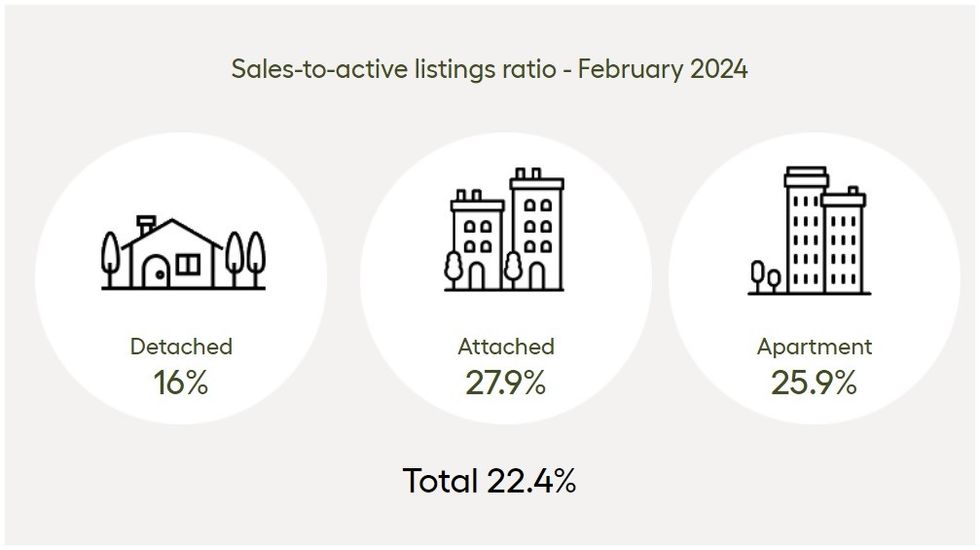Home sellers are awakening this spring, perhaps sensing that an improvement in market conditions will arrive soon, according to the latest statistics published on Monday by the Real Estate Board of Greater Vancouver, which recently rebranded as Greater Vancouver Realtors (GVR).
In February, the Greater Vancouver region recorded a total of 2,055 home sales, after recording 1,410 in January. The February total is an improvement compared to February 2023, but still well below the 10-year average of 2,699.
The supply side of the equation is fairing better, however.
A total of 4,560 new listings were added to the Greater Vancouver market in February, after 3,788 were added in January. The total was a sizeable improvement over the 3,467 recorded in February 2023, and just 0.2% below the 10-year average of 4,568.
"While the pace of home sales started the year off briskly, the pace of newly listed properties in January was slower by comparison," says GVR Director of Economics and Data Analytics Andrew Lis. "A continuation of this pattern in February would have been concerning, as it could quickly tilt the market towards overheated conditions. With new listings up about 31% year-over-year in February, this will relieve some of the pressure that was building in January and offer buyers more choice as we enter the spring and summer markets."
With that new batch of listings, Greater Vancouver Realtors says the amount of active listings in the region is up to 9,634, which they note is 3% above the 10-year seasonal average of 9,352.
However, that statistic is misleading, as it includes listings for multifamily buildings and land, which involves a different buyer pool. The true amount of residential active listings is 9,167, which is 2% below the 10-year average.
Buyers or Sellers
With the above statistics, we can identify the sales-to-new-listings ratio and sales-to-active-listings ratio, which are two quantitative indicators that give us a sense of whether the market is leaning in any particular direction — towards buyers or sellers.
For the sales-to-new-listings ratio, a ratio of 40% or lower is considered a buyers' market, a ratio of 55% or higher is considered a sellers' market, and anything in between is considered a balanced market.
With 2,055 home sales and 4,560 new listings recorded in February, the sales-to-new-listings ratio is now at 45.1%, after being at 37.2% at the end of January, which indicates movement towards sellers that's resulting in a balanced market.
For the sales-to-active-listings ratio, a ratio of 12% or lower is viewed as favouring buyers, a ratio of 20% or higher is viewed as favouring sellers, and anything in between is viewed as a balanced market.
With 2,055 home sales and 9,167 total active listings in February, the sales-to-active-listings ratio is now 22.4%, after coming in at 17.2% in January, reaffirming the movement towards sellers and perhaps indicating there's an advantage that can be found for sellers.
Zooming in, however, there is some nuance across different property types, with the sales-to-active-listings ratio at 16% for single-detached homes, 27.9% for attached homes, and 25.9% for condominiums, indicating that the sellers' market may be exclusive to the latter two property types.
Single-detached homes averaged 47 days on the market in February, while attached homes are averaging 32 days, and condos are averaging 34 days. All three decreased from January to February.

Prices and Outlook
The composite residential benchmark price in the Greater Vancouver region as of February is $1,183,300, which represents a 1.9% increase compared to January and a 4.5% increase over this time last year.
By property type, the benchmark price is now $1,972,400 for single-detached homes, $1,094,700 for attached homes, and $770,700 for condos. All three represent increases of between 1.5% and 2.6% when compared to January, as well as increases of between 4.2% and 7.2% when compared to February 2023.
"Even with the increase in new listings however, standing inventory levels were not high enough relative to the pace of sales to mitigate price acceleration in February, with most segments of the market moving into sellers' territory," noted Lis. "This competitive dynamic has led to modest price growth across all market segments this month, but it's noteworthy that benchmark prices remain below the peak observed in the spring of 2022, before the market internalized the full effect of the Bank of Canada's tightening cycle."
The Bank of Canada's next interest rate announcement is this week, on Wednesday, March 6.





















